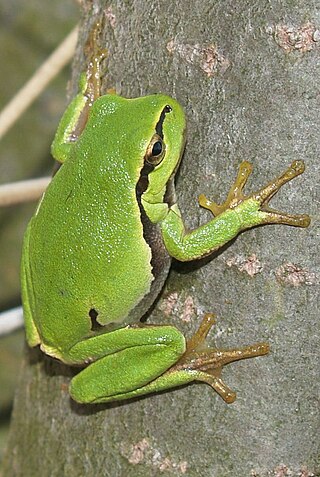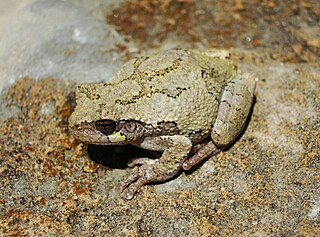
Hylidae is a wide-ranging family of frogs commonly referred to as "tree frogs and their allies". However, the hylids include a diversity of frog species, many of which do not live in trees, but are terrestrial or semiaquatic.

Ptychohyla is a genus of frogs in the family Hylidae. These frogs are found in the southern Mexican states of Chiapas, Guerrero, and Oaxaca, and Central America to western Panama.

Spikethumb frogs are a genus (Plectrohyla) of frogs in the family Hylidae found in Central America from southern Mexico through Guatemala and northern El Salvador to central and northern Honduras. A major revision of the Hylidae moved an additional 21 species to this genus from the genus Hyla. The additional species moved to Plectrohyla were identified as the Hyla bistincta group, also called the Plectrohyla bistincta group; a separate group from the initial Plectrohyla guatemalensis group. This phylogenetic classification was later revised by moving the Plectrohyla bistincta group from the genus Plectrohyla into a new genus called Sarcohyla. Meanwhile, the guatemalensis group remained in Plectrohyla. They are called spikethumb because of the spike on their thumbs, which is called a prepollex. The genus name comes from the Greek word plēktron ("spur") and hyla.

Charadrahyla is a genus of frogs in the family Hylidae. It is endemic to tropical southern Mexico. The generic name was derived from Greek charadra ("ravine") and Hyla, in reference to the habits of these frogs. Accordingly, common name ravine treefrogs has been coined for the genus.
Megastomatohyla is a genus of frogs in the family Hylidae. They are endemic to the cloud forests of central Veracruz and Oaxaca, Mexico. All are rare species with restricted distributions. The generic name is derived from Greek mega (="large") and stem of the genitive stomatos (="mouth"), referring to the enlarged oral disc of the tadpoles, juxtaposed with Hyla, the genus in which the four Megastomatohyla species were previously placed. Common name large-mouthed treefrogs has been coined for this genus.

Ecnomiohyla, commonly known as fringe-limbed treefrogs or marvelous frogs, is a genus of frogs in the family Hylidae. This genus was erected in 2005 following a major revision of Hylidae. The ten original species in this genus were previously placed in the genus Hyla. The generic name Ecnomiohyla comes from Greek ecnomios and Hylas, the companion of Hercules.

Sarcohyla bistincta, also known as the Mexican fringe-limbed treefrog or Cope's streamside treefrog, is a species of frog in the family Hylidae. It is endemic to Mexico; it is widespread and occurs from southern Sinaloa and Durango southeastward to Veracruz and Oaxaca. The nominal Sarcohyla bistincta consists of several lineages that may eventually be described as distinct species.

Sarcohyla labeculata is a species of frog in the family Hylidae. It is endemic to the Sierra Mixe in Oaxaca, Mexico. This species was resurrected from synonymy of Sarcohyla bistincta in 2018, while at the same time bringing Sarcohyla calthula and Sarcohyla ephemera in its synonymy. Common name Mixe streamside treefrog has been proposed for this species, whereas the common names yellow-robed treefrog and Cerro Las Flores spikethumb frog referred to the former S. calthula and S. ephemera, respectively.
Sarcohyla celata, also known as the Oaxaca treefrog, is a species of frog in the family Hylidae. It is endemic to Mexico and only known from the Sierra de Juárez in northern Oaxaca. After having not been seen after 1984, it was feared that the species might be extinct. However, the species was rediscovered in field surveys during 2011–2014 and some subpopulations are at healthy levels.
Sarcohyla cembra, also known as the Southern Sierra Madre treefrog, is a species of frog in the family Hylidae. It is endemic to Mexico. Until recently, it was only known from two male specimens: one from its type locality on the Pacific slopes of the Sierra Madre del Sur mountains, Pochutla District, Oaxaca, and another one from Sierra de Yucuyacua south-east of Llano de Guadalupe, in north-west Oaxaca. The two locations are about 172 km (107 mi) apart. After having not been seen after 1993, it was feared that the species might be extinct. However, the species was rediscovered in field surveys in 2011–2012, extending its range with a new locality about 10 km north of the type locality.
Sarcohyla cyanomma, also known as the blue-eyed aquatic treefrog, is a species of frog in the family Hylidae. It is endemic to Mexico and only known from the northern slope of Cerro Pelón, in Sierra de Juárez in northern Oaxaca. It is feared that the species might be extinct.
Sarcohyla sabrina, also known as the Sierra Juarez treefrog, is a species of frog in the family Hylidae. It is endemic to the northern slopes of Sierra de Juárez in northern Oaxaca, Mexico. The specific name sabrina is Latin for river nymph and refers to the close association of this species with streams.
Plectrohyla tecunumani is a species of frogs in the family Hylidae. It is endemic to the Sierra de los Cuchumatanes in western Guatemala. Its specific name refers to Tecun Uman, the Guatemalan national hero. Common name cave spikethumb frog has been coined for it.
Sarcohyla miahuatlanensis, or the Sierra Miahuatlan spikethumb frog, is a species of frog in the family Hylidae. It is endemic to Mexico and only known from its type locality near Candelaria Loxicha on the Sierra de Miahuatlán in Oaxaca.

Hylinae is a large subfamily of "tree frogs", family Hylidae.
Jonathan Atwood Campbell is an American herpetologist. He is currently professor of biology at University of Texas at Arlington. He was a distinguished professor and chair of the Department of Biology, University of Texas at Arlington, Arlington, Texas.

Dryophytes is a genus of Ameroasian tree frogs in the family Hylidae. They are found mostly in North America, but the genus also includes three species found in eastern Asia.

Rheohyla is a genus of frogs in the family Hylidae. As currently recognized, it is monotypic, containing only Rheohyla miotympanum, also known as the small-eared hyla or small-eared treefrog. However, the nominal species likely is a complex of more than one species. It is endemic to eastern and central Mexico. The generic name refers to streams, the breeding habitat of this frog. The specific name is derived from Greek meion, a diminutive prefix, together with Greek tympanon (='drum') and refers to the small tympanum.
Sarcohyla hapsa, the northern streamside tree frog, is a frog in the family Hylidae, endemic to Mexico.










